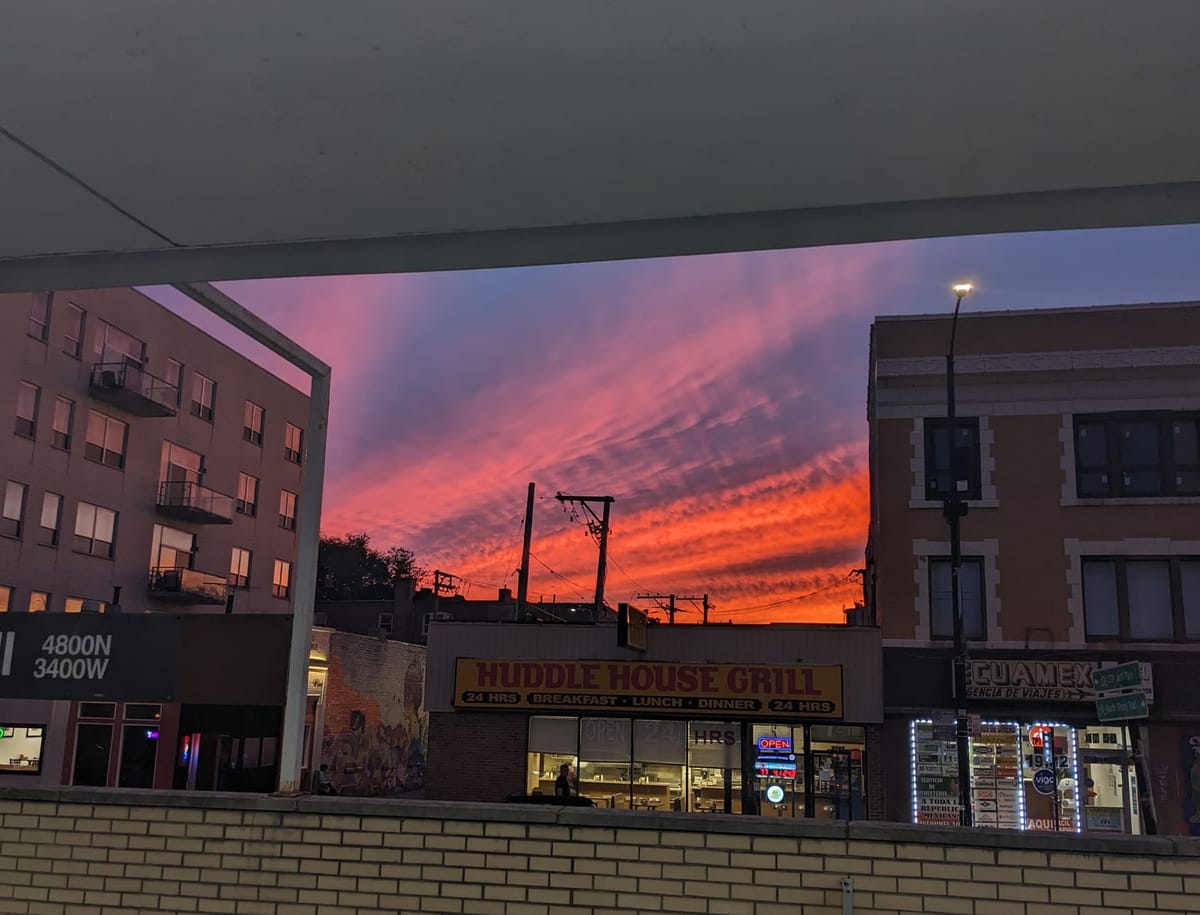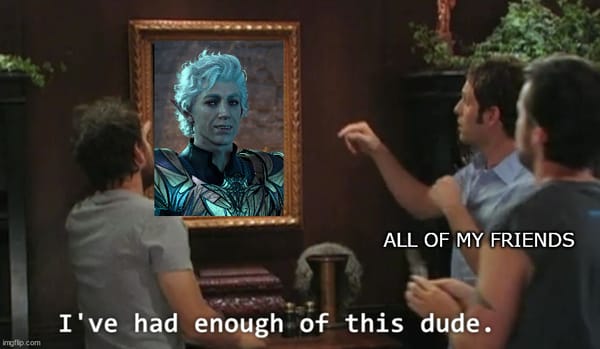Vignettes #3

A small announcement: A short story of mine, "The Buried House," has been accepted for publication by The Colored Lens! It will be out in January in their Winter 2025 issue. I'm so honored and excited. I'll send out more info when it's out, but for now you can follow The Colored Lens on Bluesky here.
I wrote a lot of this post over the summer and never sent it, so it's a bit outside of time. But here you go.
My apartment is a fifteen-minute walk from the local library, a straight shot west on my very street. I take this walk often because when I’m working from home it’s the perfect way to feel free after clocking out. On the way I pass by a local Neapolitan pizza place, a doggy daycare, a community garden along the train tracks, and houses, so many houses. I like to take one side of the street on the way there and another side of the street on the way back so I don’t miss anything. I covet these houses, I really do – I look at them and imagine what my life would be like inside and outside of them. A life with a porch swing, a garden full of peonies, a tetherball pole out front. Bookcases along a whole wall and stairs leading up. One of the houses I pass has a small basketball court on top of its garage, which baffles me every time I see it. I picture a crowd of children dribbling too hard at the same time and crashing through the ceiling onto a Tesla in the garage below.
I rent, obviously. I’ve lived in five different apartments since 2018, and I’ve had to fight hard to nest in every one.
So what is it like to have a garden to till? What is it like to have gutters to clean of leaves? What’s it like to leave your home and know no one can stop you coming back to it because it’s yours? All yours - to paint and love and wreck as you please.
I saw Longlegs when it was in theaters. It was touted by critics and popular audiences alike as a modern Silence of the Lambs, which I thought referred to its general fear factor and basic premise. In the film, a young female FBI agent tracks a serial killer and becomes personally involved in the case, but the similarities don’t end there. To my distaste, Longlegs actually also carries on Silence of the Lambs’ legacy of transmisogyny. The film’s serial killer, the titular Longlegs, is an unrecognizable Nicolas Cage, done up in prosthetics, cakey face makeup, a long, tangled wig, and ill-fitting, feminine sweaters. Longlegs speaks in a falsetto and targets young girls as his prey. He also makes deeply creepy life-size dolls in their likenesses, vessels which turn out to hold the devil inside. Longlegs’ appearance and behavior is nodded at through glam rock posters in his workshop and the songs he listens to on the radio, implying it to be more of an emulation of an era where musicians would adopt markers of femininity as cis men to be transgressive and rebellious. Writer/director Osgood Perkins (son of the late actor Anthony Perkins, and perhaps best known otherwise for his appearance as a side character in Legally Blonde) apparently had an entire backstory explaining Longlegs’s appearance as someone who had a lot of plastic surgery done to craft themselves perfectly to impress Satan. This is never mentioned in the movie itself, but I’m having issues deciding if it would’ve made the transmisogyny of it all more or less overt if it had.
I mostly watched the events of the film unfold in a state of exasperation, wondering if anyone had pointed out this pattern in the making and tried to change it. The devil infiltrating victims’ homes through the likenesses of young women who were not young women at all, false imitations of the real thing. Longlegs’s creepiness meant to come from his hapless attempts to emulate a feminine sort of physical perfection. It doesn’t seem to have been done intentionally at all – Perkins’s overt commentary was more about the insidiousness of organized religion, which also factors heavily into the film, and later made his support of trans people very clear in a Reddit AMA – but the hallmarks of this trope are all there.
Longlegs still had its moments. In the scene where federal agents first discover one of the dolls, you wait an uncomfortably long stretch of time knowing its eyes will fly open. So I kept my own closed.
This summer, a friend of mine from grad school moved back home to a country all the way across the world. On a train ride before he left we talked about the tenuousness of our futures. How none of our communities are stably located in one place. His family is in a time zone 13 hours different from the one he's lived in the past three years. But a lot of his career also belongs where his family is. He doesn’t know how long he’ll be anywhere after this next year. Here in Chicago, too, I’m not sure where anyone is going to be. Many of us are rootless because our plans won’t let us have them – friends in medical school have to go wherever their residencies will take them, just for one example, though they have some limited ways to control it. My family is mostly in New Jersey and California. My friends are in Boston, Lansing, Los Angeles, Seattle, all over. I lament all the time that I can’t just make all of my friends pick up and move with me wherever I would like to make my life. Oh, they have networks they’d take with them if they could, too? Too bad! I’m the center of this web.
This is about leaving – it’s fine and necessary if I do it, but nobody else is allowed.
In The Substance, fading star Elisabeth Sparkle (portrayed by Demi Moore) injects herself with a mysterious drug in order to generate a younger, “more perfect” version of herself. This young version of herself, played by Margaret Qualley and dubbed Sue, can be out in the world for only seven days at a time, after which she must switch back with Elisabeth, and so on into perpetuity. Of course, the lure of being young, beautiful and famous again is too tempting for Elisabeth/Sue, and they begin pushing the boundaries of the Substance’s rules to increasingly dire consequences. The film takes jabs at many topics, including stereotypically patriarchal standards of beauty and control of the entertainment industry, the desire to appear young, the shallowness of dating in the modern age, fitness and diet culture. Most of all it observes the body – how we perceive our own bodies and the bodies of others, especially those of women in the spotlight.
The Substance was slickly shot, squelchy in sound design, and silly as all hell. There’s a much more serious movie in there that sympathizes with the plight of women in the public eye, but I’m not sure it would’ve been a better one. The movie as it stands holds as much contempt for women who try to hold onto youth, beauty and fame as the straight men who insist they do so. As a viewer, you want Demi Moore’s Elisabeth to work through her self-consciousness over her aged appearance to go on a date with someone who values her as she is, but of course she can’t. She wants the wrong things, and it’s not really her fault, but she’ll be punished for it anyway. The last 30 minutes or so of the film was a ridiculous, squishy blood-fest, something the movie could’ve done without if it weren’t also so entertaining.
Genuinely. What a squelchy movie.
Miscellanea
- I appreciated Noah Berlatsky's analysis for CNN of Longlegs's contribution to negative trans stereotypes as well.
- Game Awards news I was most excited about is the Okami Sequel. That and a new game from the makers of Ico and Shadow of the Colossus! But mostly excuse me while I cry about Okami, now and forever.
- Once again I entreat you to join me and others on Bluesky if you are still looking for someplace to sate your scripturience. Twitter has been terrible for a long time and had its deep problems before the takeover, but do you really want to be supporting Elon Musk now? Of all times?
- More power to you if you left Twitter and didn't go anywhere else. Be free! Touch grass and tell me what it's like! I don't have your strength. I'm making linocut stamps and posting over there about them.



